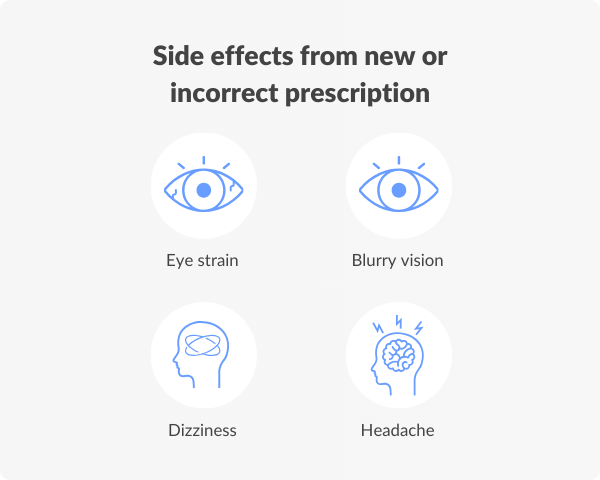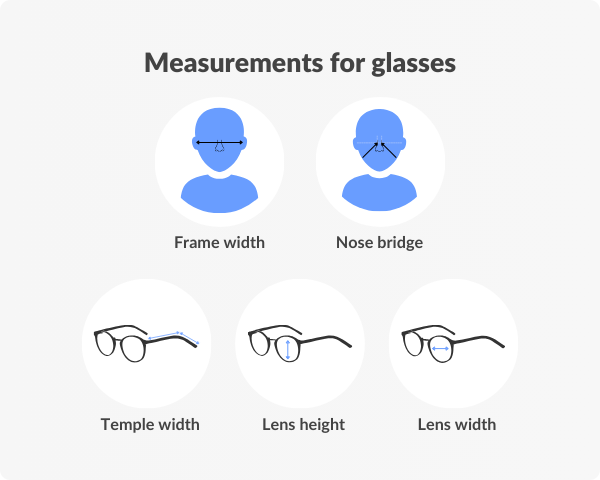Can Glasses Cause Headaches?

Reviewed by
Maria Horan FBDO
If your glasses have recently started giving you headaches, you’re not alone.
It’s common for both adults and children to experience discomfort and it can be due to different reasons.
In this article, we discuss what is the link between eyeglasses and headaches and how you can address the issue to ensure your frames are helping and not hurting your well-being.
Can glasses really cause headaches?
In some cases, wearing glasses can lead to mild headaches, dizziness or blurry vision. The reason can be a new or incorrect prescription, poorly fit frames or eye muscle strain.
It can also happen from using the wrong type of glasses, such as wearing distance glasses while working on a computer or vice versa; using reading glasses while trying to see things that are far away.
Regular eye exams can help prevent any eye problems and discomfort by ensuring you have the right prescription as your vision changes over time.
How can glasses cause headaches?
Headaches from glasses can be frustrating and uncomfortable. Understanding the origin and common causes can help you address the issue and find a suitable solution as soon as possible.
New or incorrect prescription
When you get new eyeglasses or your prescription changes, your eyes need time to adjust. During this adjustment period, which can sometimes take some days, you can experience mild headaches or eye strain.
Blurred vision may occur when you take off your glasses due to the image shift. Wearing glasses to correct your vision moves the image onto your retina, but removing them causes the image to shift and blur.
Switching to progressive lenses can also cause temporary headaches because your eyes are still adapting to the different visual zones, which can be challenging at first.
If the prescription provided by your eye doctor is incorrect, and the lenses don’t properly correct your vision, it can also strain your eye muscles and cause headaches.
If your prescription is correct however, it’s important to understand that the adjustment period will pass, and giving up too soon without allowing time for your eyes to adapt won’t help alleviate the headaches.

Poorly fitted glasses
The fit of your glasses is crucial for comfort. Glasses frames that are too tight behind your ear can create pressure on the mastoid bone, a part of your skull located just behind the ear, which can lead to frontal headaches.
On the other hand, glasses that are too loose may slip down your nose, causing you to constantly adjust them, which can also lead to discomfort.
If your frames are fitted accurately, then the issue may be an incorrect pupillary distance (PD) measurement which is a mismatched distance between your pupils.
If your PD measurements are inaccurate and off by two millimeters and up, this can cause blurry or distorted vision, and possibly headaches.
If your eye doctor has not included your PD on your prescription, there are online tools available to get your pupillary distance from home.
Digital eye strain
If you wear glasses while working on a computer and are experiencing headaches and blurred vision, the discomfort may be due to digital eye strain rather than the prescription or fit of the frames.
Looking at digital screens for a prolonged period of time can strain the eyes. We tend to blink less which may result in dry, itchy, or red eyes.
Glasses with an anti-reflective coating or blue light filters can help reduce this strain and prevent headaches.

How much time does it take to get used to new glasses?
Adjusting to new glasses or a new prescription is an expected process that can take up to two weeks for both adults and children.
During this period, it’s normal to experience some slight dizziness or have difficulty focusing as your eyes are adapting to the new lenses.
If your symptoms continue for more than two weeks, it’s advisable to consult an eye care professional to ensure your prescription and fit are correct.
DID YOU KNOW?
The brain plays a significant role in adjusting to new glasses. Engaging in activities that require focus, such as reading or playing video games, can help speed up the adjustment process.
Tips for preventing headaches
There are a few things you can do to help relieve headaches and let you wear your glasses without the discomfort.
Adjust your frames
If your glasses are loose around your ears, pinching the bridge of your nose, or too tight on your face, you can try adjusting the frames at home or visiting your local optician to help with the adjustment.
When buying a new pair of glasses, to reduce the chances of having to adjust your frames post-purchase, make sure you understand your face measurements and know your correct pupillary distance measurement to ensure your glasses fit you well.
Asking your eye doctor for a comprehensive eye exam is the best way to get accurate analysis of the frame width, eye size, nose bridge, temple length, lens height, and width.
Wear lightweight frames
Heavy frames or lenses can create pressure points on your nose and behind your ears, leading to discomfort and even neck pain.
If you choose frames made from lightweight and durable materials like titanium or plastic, you can reduce the likelihood of headaches without having to sacrifice style for comfort.
Pairing them with polycarbonate lenses or selecting a high index lens will make the glasses more comfortable by reducing their lens thickness.

Limit daily screen time
Whether you’re wearing eyeglasses or not, spending too much time looking at digital screens can strain your eyes and cause headaches.
A popular method to relieve eye strain is to take periodic breaks by following the 20-20-20 rule; look at something 20 feet away for 20 seconds every 20 minutes.
It’s a great way to reduce eye fatigue and let your eyes refocus and regain moisture by blinking and looking at non-backlit objects.
Use blue light-blocking glasses
Blue light glasses filter out 25-30% of all blue light and reduce the glare from the surrounding digital devices.
Wearing these glasses can help prevent headaches and improve overall eye comfort.
If your daily life requires longer exposure to LED screens, you may develop the symptoms of computer vision syndrome (CVS), which include irritation, blurry vision, headaches, and eye strain.
So, even if you don’t need prescription glasses, you can take advantage of wearing blue light glasses to keep your eyes safe and healthy.
Understanding the link between eyeglasses and headaches
Headaches from glasses are a common issue that can come from new or incorrect prescriptions, poorly fitted frames, or digital eye strain.
Understanding the causes and taking proactive steps to address these factors can greatly improve your comfort and overall eye health.
If you’re curious to learn more about other eye-related topics, feel free to explore our Optical Center.










































